Part 6

I told you the train station was huge - this is only the ground floor, the underground part of the station is for the local S-Bahn trains. The trains headed for other cities are marked "Fernverkehr" - the 9:30AM Munich train appeared on the bottom of the sign about a minute after the picture was taken. You can't see it in this picture, but the bustling Christmas market was off to the right below the "Rail City" sign.
John Atwood had left in the early morning, so our little party was down to two - Gary Pimm (on the left), and myself. On to Munich, where we'd be greeted at the train station by Allen Wright, our host for the Munich part of the trip.
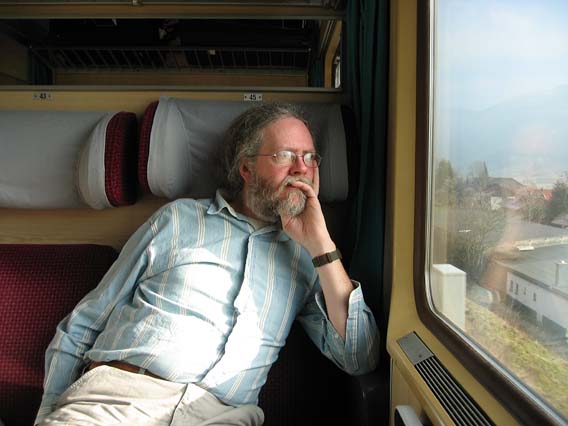
Gary Pimm in a travel daze, looking at the frosty German countryside rolling by. We had to get up fairly early for the train, and for some idiotic reason (to save money, I think) decided to schlep ourselves - and our techno-heavy luggage - about 1km from the hotel to the train station. Not so bad, except for the curbs and a very rough cobblestoned section about a block long. We were ready for a rest when the train for Munich pulled into the station.
Nice trip, though. Very relaxing 4-hour trip in first-class compartment we had to ourselves, giving room to stretch out and snooze if we felt like it. A snack cart came by every hour or so, offering a variety of breakfast goodies and the inevitable "mineralwasser mit gas". This was a very nice treat as we rolled through the countryside. I'd recommend European train travel to anyone - great scenery, flawless silky-smooth track, a roomy compartment, and a pleasant time to decompress from the rest of the trip. Far better than a crowded, noisy bus or airplane, and no comparison at all to Amtrack (which, bumpy track, late trains and all, is still a lot better than flying.)
The train trip was fun and relaxing, and we were ready for Allen when we met him at the main Munich station. From there we caught a local S-Bahn that went straight to the hotel, and settled in for our first night in Munich, a much bigger city than small-town Zurich.
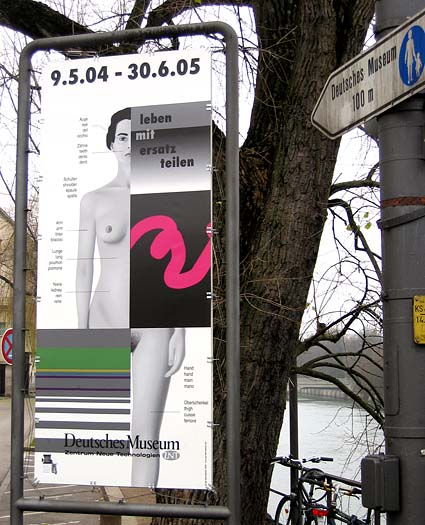
The main sign to Germany's biggest and oldest technology museum, the Deutsches Museum, celebrating its 100th anniversary. This museum is really huge - imagine the Smithsonian all in one building, that'll give you an idea of the size of this thing. Exhibits you don't see anywhere else, like a V-2 rocket, a Fokker trimotor, a full-sized cross-section of a Boeing 747, a Soyuz space capsule - and that's just one part of the museum!
Um, yes, I agree, that's a sign unlikely to be seen in family-values America any time soon. When I watch American TV tell us - over and over again - how America is the freest country in the world, I think of this can't-be-shown-in-America poster for a science museum, gathering no special attention at all on a busy street in the middle of a major European city. By the way, I didn't see a single German flag, either, but did see quite a few multistar EU flags. Wow, without seeing flags everywhere, how do the Germans remember they're German?
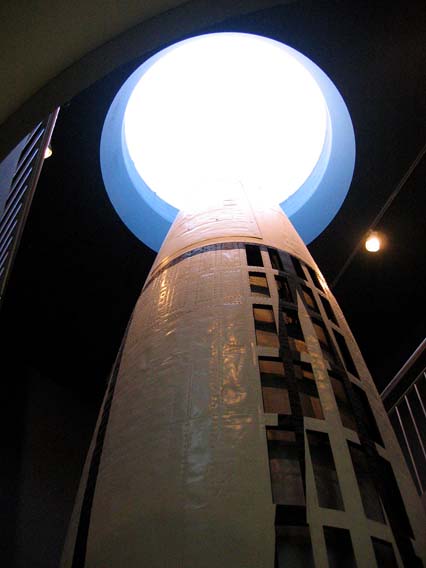
Things like this probably help them remember. Yes, it's a real V-2 rocket, not all that far from where they were first made sixty years ago. The museum has an stunning layout - the spiral staircase wraps around the rocket, extending five floors, with the ground floor showing ground transportation, the floors above aviation, and the top floor devoted to space travel. And the floors in the middle are big, with space enough for a Fokker trimotor on the second floor!
Just to give you a sense of scale, everything you see here is life-size, not models, but real airplanes, including the WWII German rocket-plane in the lower right of the picture. One thing missing are any Nazi insignia - you see German crosses, but no swastikas, despite the fact these are real Luftwaffe aircraft and rockets, not replicas.
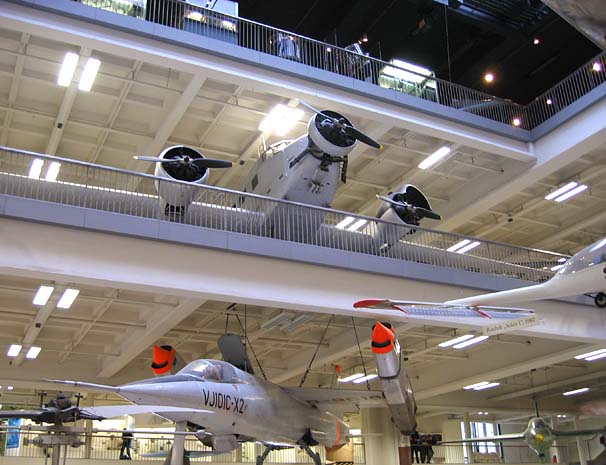
My understanding is that displaying Nazi insignias, even in a museum, is illegal in Germany. The rose-colored sentimental views Americans have of World War II - "The Greatest Generation" and all that - are not shared by Europeans. What for Americans is an old-timey documentary on the History Channel, or a first-person-shooter computer game, is a bitter memory those who lived through the horrors of World War II, followed by Stalin's occupation and police-state dictatorship of half of Europe.
They see the past in a much deeper context than Americans - Europe is the place where the Inquisition and witch-hunts started, followed by centuries-long religious wars between Catholics and Protestants, endless wars of rival Empires, and most terrible of all, Fascism and Communism were born. It was a long, difficult struggle to reach the modern EU era of peace, democracy, and religious tolerance. Europeans know their history. Having lived through so much, they do not romanticize war.
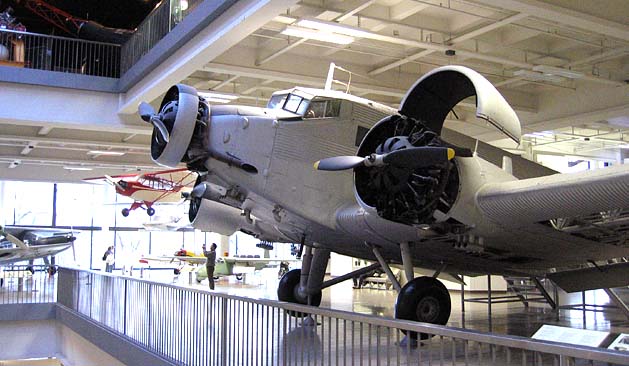
You can climb into the insignia-less Fokker trimotor, look through the pilot's windshield, and get a a vertigo-inducing view of the floors below. Yes, I tried it, the effect works. Note the Mercury space capsule in the upper left corner of the picture, on the "Space" floor.
From the here, we moved to quieter parts of the museum, looking back at the older technology and arts of Germany. This museum is so large you have to take breaks every hour or so, otherwise you just kind of blot out everything from overstimulation. As you can see, the displays are dense, and every one has many tiny details and other displays nearby that show subtopics related to the main displays.
It takes a while to dawn on you that you could literally spend weeks here - and the Deutsches Museum is only one of several world-class museums, art galleries, palaces, and opera houses in Munich. At that point you slow down a little and realize you'll see what you'll see, and simply enjoy what you run into as you stroll around.
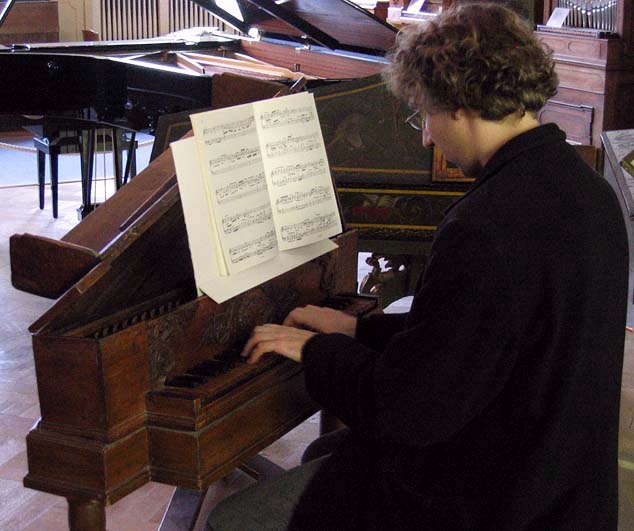
We listened to Baroque music at the Deutsches Museum on a 16th-Century harpisichord - a deeply profound and moving experience. We heard three different instruments, none made later than the 17th Century. All of them had a wonderful shimmering bell-like tonality, like listening to a chorus of harps playing in the distance on a fragrant breeze. Truly beautiful, the highlight of the day and of the entire trip.
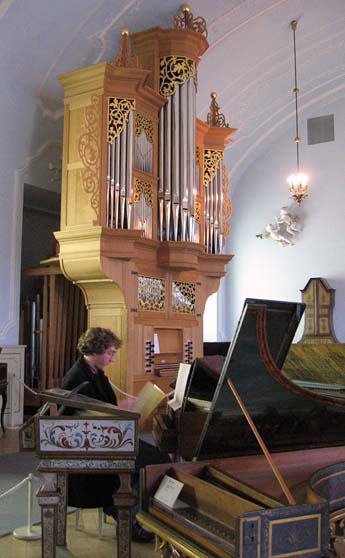
Another view of the music room showing the pipe organ in the background. We were told by the musician they will come out with a CD of these very instruments in January of 2005 - looking forward to listening to the recording.
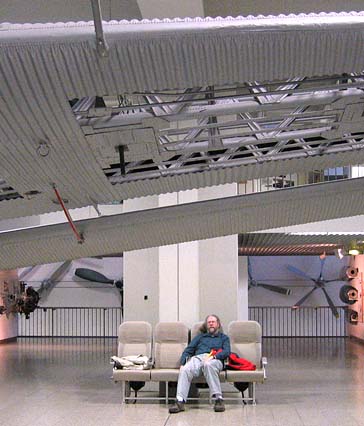
Zzzz. A long day at the Deutsches Museum, time to go back to the hotel, and rest up for our last day in Europe. Note the cool chairs for tired museum-goers, definitely a good idea that other cultural attractions ought to try.
Text and Pictures © Lynn Olson 2004, except where noted.